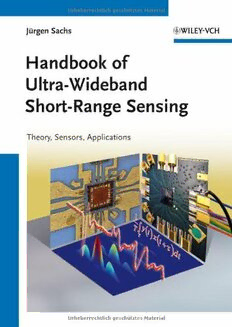
Handbook of Ultra-Wideband Short-Range Sensing: Theory, Sensors, Applications PDF
Preview Handbook of Ultra-Wideband Short-Range Sensing: Theory, Sensors, Applications
JürgenSachs Handbookof Ultra-Wideband Short-RangeSensing RelatedTitles Haykin,S.(ed.) Arslan,H.,Chen,Z.N.,DiBenedetto, AdaptiveRadarSignal M.-G.(eds.) UltraWidebandWireless Processing Communication 230pages 2006 520pages Hardcover 2006 ISBN:978-0-471-73582-3 Hardcover ISBN:978-0-471-71521-4 Allen,B.,Dohler,M.,Okon,E.,Malik,W., Brown,A.,Edwards,D.(eds.) Sengupta,D.L.,Liepa,V.V. UltraWidebandAntennasand AppliedElectromagneticsand Propagationfor ElectromagneticCompatibility Communications,Radarand 486pages Imaging 2005 Hardcover 508pages ISBN:978-0-471-16549-1 2006 E-Book ISBN:978-0-470-05682-0 Jürgen Sachs Handbook of Ultra-Wideband Short-Range Sensing Theory,Sensors,Applications TheAuthor AllbookspublishedbyWiley-VCHarecarefully produced.Nevertheless,authors,editors,and Dr.-Ing.JürgenSachs publisherdonotwarranttheinformationcontained IlmenauUniversityofTechnology inthesebooks,includingthisbook,tobefreeof ElectricalEngineeringandInformation errors.Readersareadvisedtokeepinmindthat Technology statements,data,illustrations,proceduraldetailsor InstituteforInformationTechnology otheritemsmayinadvertentlybeinaccurate. ElectronicMeasurementResearchLab LibraryofCongressCardNo.:appliedfor Ilmenau,Germany BritishLibraryCataloguing-in-PublicationData Acataloguerecordforthisbookisavailablefrom theBritishLibrary. BibliographicinformationpublishedbytheDeutsche Nationalbibliothek TheDeutscheNationalbibliothekliststhis publicationintheDeutscheNationalbibliografie; detailed bibliographicdataareavailableonthe Internetathttp://dnb.d-nb.de. #2012Wiley-VCHVerlag&Co.KGaA,Boschstr.12, 69469Weinheim,Germany Allrightsreserved(includingthoseoftranslationinto otherlanguages).Nopartofthisbookmaybe reproducedinanyform–byphotoprinting, microfilm,oranyothermeans–nortransmittedor translatedintoamachinelanguagewithoutwritten permissionfromthepublishers.Registerednames, trademarks,etc.usedinthisbook,evenwhennot specificallymarkedassuch,arenottobeconsidered unprotectedbylaw. PrintISBN: 978-3-527-40853-5 ePDFISBN: 978-3-527-65184-9 ePubISBN: 978-3-527-65183-2 mobiISBN: 978-3-527-65182-5 oBookISBN: 978-3-527-65181-8 CoverDesign Adam-Design,Weinheim Typesetting ThomsonDigital,Noida,India PrintingandBinding MarkonoPrintMediaPteLtd, Singapore PrintedinSingapore Printedonacid-freepaper j V Contents Preface XV ListofContributors XIX 1 Ultra-WidebandSensing–AnOverview 1 1.1 Introduction 1 1.2 Ultra-Wideband–DefinitionandConsequencesofaLarge Bandwidth 7 1.2.1 BasicPotentialsofUltra-WidebandRemoteSensing 9 1.2.2 RadiationRegulation 10 1.2.2.1 ImplicationofUWBRadiationonBiologicalTissue 14 1.3 ABriefHistoryofUWBTechnique 16 1.4 InformationGatheringbyUWBSensors 17 References 27 2 BasicConceptsonSignalandSystemTheory 31 2.1 Introduction 31 2.2 UWBSignals,TheirDescriptionsandParameters 32 2.2.1 ClassificationofSignals 32 2.2.1.1 TypesofStimulusSignals 32 2.2.1.2 RandomProcess 33 2.2.1.3 AnalogueandDigitalSignals 34 2.2.2 SignalDescriptionandParametersofCompactSignals intheTimedomain 35 2.2.2.1 BasicShapeParameters 35 2.2.2.2 L -norm 38 p 2.2.2.3 ShapeFactors 40 2.2.2.4 TimePosition 41 2.2.2.5 IntegralValuesofPulseDuration 42 2.2.3 StatisticalSignalDescriptions 43 2.2.3.1 ProbabilityDensityFunctionandItsMoments 43 2.2.3.2 IndividualSignal 44 2.2.3.3 RandomProcess 45 2.2.4 SignalDescriptionofContinuousWave(CW)UWBSignals 49 j VI Contents 2.2.4.1 Auto-CorrelationFunction 50 2.2.4.2 Cross-CorrelationFunction 52 2.2.5 FrequencyDomainDescription 54 2.2.5.1 TheFourierSeriesandFourierTransformation 55 2.2.5.2 SomePropertiesandParametersofaSpectrum 59 2.2.5.3 Time-BandwidthProducts 61 2.2.6 DopplerScalingandAmbiguityFunction 65 2.3 SomeIdealizedUWBSignals 71 2.3.1 RectangularUnipolarandBipolarPulseTrains 72 2.3.2 SingleTriangularPulse 72 2.3.3 SincPulse 73 2.3.4 GaussianPulses 75 2.3.5 BinaryPseudo-NoiseCodes 79 2.3.6 Chirp 86 2.3.7 Multi-Sine 88 2.3.8 RandomNoise 91 2.4 FormalDescriptionofDynamicSystems 94 2.4.1 Introduction 94 2.4.2 TimeDomainDescription 96 2.4.2.1 Linearity 96 2.4.2.2 TheImpulseResponseFunctionortheTimeDomainGreen’s Function 97 2.4.2.3 ExtractionofInformationfromtheImpulseResponse Function 103 2.4.3 TheFrequencyResponseFunctionortheFrequencyDomain GreensFunction 107 2.4.3.1 PropertiesoftheFrequencyResponseFunctionandtheUtility oftheFrequencyDomain 109 2.4.3.2 ParametersoftheFrequencyResponseFunction 111 2.4.4 ParametricSystemDescriptions 112 2.4.4.1 DifferentialEquation 112 2.4.4.2 TheLaplaceTransform 114 2.4.4.3 TransferFunction 115 2.4.4.4 StateSpaceModel 118 2.4.5 TimeDiscreteSignalandSystems 124 2.4.5.1 DiscreteFourierTransform 125 2.4.5.2 CircularCorrelationandConvolution 126 2.4.5.3 DataRecordLengthandSamplingInterval 127 2.5 PhysicalSystem 132 2.5.1 EnergeticInteractionandWaves 132 2.5.2 N-PortDescriptionbyIV-Parameters 135 2.5.3 N-PortDescriptionbyWaveParameters 138 2.5.4 DeterminationofN-PortParameters 142 2.6 MeasurementPerturbations 146 2.6.1 AdditiveRandomNoiseandSignal-to-NoiseRatio 146 j Contents VII 2.6.1.1 Signal-to-NoiseRatio(SNR) 148 2.6.1.2 SlidingAverage 149 2.6.1.3 SynchronousAveraging 151 2.6.1.4 MatchedFilter/Correlator 152 2.6.1.5 DeviceInternalNoise 157 2.6.1.6 QuantizationNoise 158 2.6.1.7 IRFandFRFEstimationfromNoisyData 166 2.6.2 NarrowbandInterference 168 2.6.3 JitterandPhaseNoise 170 2.6.3.1 TriggerJitter 170 2.6.3.2 PhaseNoise 173 2.6.3.3 CycleJitter 175 2.6.3.4 OscillatorStability 177 2.6.4 LinearSystematicErrorsandtheirCorrection 178 2.6.5 Non-LinearDistortions 189 2.6.6 DynamicRanges 191 2.7 Summary 195 References 195 3 PrincipleofUltra-WidebandSensorElectronics 199 3.1 Introduction 199 3.2 DeterminationoftheSystemBehaviourbyPulse Excitation 201 3.2.1 BasicPrinciple 201 3.2.2 PulseSources 203 3.2.2.1 MonolithicallyIntegratedPulseSources 203 3.2.2.2 TunnelDiode 204 3.2.2.3 AvalancheTransistor 204 3.2.2.4 StepRecoveryDiode(Snap-OffDiode) 206 3.2.2.5 Non-LinearTransmissionLine 206 3.2.3 VoltageCapturingbySub-Sampling(StroboscopicSampling) 207 3.2.3.1 PreliminaryRemarks 207 3.2.3.2 PrinciplesofVoltageSampling 208 3.2.3.3 TimingofDataCapturingbySub-Sampling 223 3.2.4 VoltageCapturingby1bitConversion 236 3.2.5 PeculiaritiesofSensorswithPulseExcitation 240 3.3 DeterminationoftheSystemBehaviourbyExcitationwith Pseudo-NoiseCodes 243 3.3.1 GenerationofVeryWidebandPN-Codes 243 3.3.2 IRFMeasurementbyWidebandCorrelation 247 3.3.3 TheSlidingCorrelator 248 3.3.4 BasicConceptofDigitalUltra-WidebandPN-Correlation 251 3.3.4.1 DigitalImpulseCompression 255 3.3.4.2 TransformationintotheFrequencyDomain 257 3.3.4.3 RemovalofStationaryData 258 j VIII Contents 3.3.5 SomeParticularitiesofPN-SequenceDevices 262 3.3.6 SystemExtensionsofDigitalPN-Correlator 266 3.3.6.1 ImprovingtheSamplingEfficiency 266 3.3.6.2 MiMo-MeasurementSystem 275 3.3.6.3 Up–Down-Conversion 278 3.3.6.4 EquivalentTimeOversampling 283 3.3.6.5 BeamSteeringandDopplerBank 287 3.3.6.6 Transmitter–ReceiverSeparation 293 3.4 DeterminationoftheSystemBehaviourbyExcitationwithSine Waves 296 3.4.1 Introduction 296 3.4.2 MeasurementoftheFrequencyResponseFunctions 297 3.4.2.1 HomodyneReceiver 297 3.4.2.2 HeterodyneReceiver 299 3.4.3 SineWaveSourcesofVariableFrequency 302 3.4.4 OperationalModes 306 3.4.4.1 SteppedFrequencyContinuousWave(SFCW) 306 3.4.4.2 ContinuousFrequencyVariation 317 3.5 TheMulti-SineTechnique 323 3.6 DeterminationoftheSystemBehaviourwithRandomNoise Excitation 330 3.6.1 TimeDomainApproaches 334 3.6.2 FrequencyDomainApproaches 338 3.7 MeasuringArrangements 341 3.7.1 CapturingofVoltageandCurrent 341 3.7.2 BasicMeasurementCircuit 343 3.7.3 MethodsofWaveSeparation 347 3.7.3.1 WaveSeparationbyTimeIsolation 347 3.7.3.2 WaveSeparationbyDirectionalCouplers 351 3.7.3.3 WaveSeparationbyVoltageSuperposition 351 3.7.3.4 CapturingofE-andH-Field 353 3.8 Summary 354 References 356 4 Ultra-WidebandRadar 363 4.1 Introduction 363 4.2 DistributedSystem–theMeasurementProblem 363 4.3 PlaneWaveandIsotropicWaves/NormalizedWave 368 4.4 TimeDomainCharacterizationofAntennasandtheFreeSpaceFriis TransmissionFormula 379 4.4.1 Introduction 379 4.4.2 AntennaasTransmitter 382 4.4.3 AntennaasReceiver 384 4.4.4 TransmissionBetweenTwoAntennas–TheScalarFriisTransmission Formula 385 j Contents IX 4.5 IndirectTransmissionBetweenTwoAntennas–TheScalarTime DomainRadarEquation 388 4.5.1 WaveScatteringatPlanarInterfaces 388 4.5.2 WaveScatteringatSmallBodies 391 4.6 GeneralPropertiesofUltra-WidebandAntennas 405 4.6.1 CanonicalMinimum-ScatteringAntenna 409 4.6.2 SpectralDomainAntennaParameters 412 4.6.3 TimeDomainAntennaParameters 417 4.6.3.1 EffectiveCentreofRadiation 420 4.6.3.2 BoresightDirectionandCanonicalPosition 424 4.6.3.3 TimeDomainDirectiveGainPattern 425 4.6.3.4 SphericalDeformationPattern 425 4.6.3.5 FidelityandFidelityPattern 425 4.6.3.6 StructuralEfficiencyPattern 426 4.6.4 ParametricDescriptionofAntennaandScatterer 427 4.6.5 DistanceandAngularDependenceofAntennaFunctionsand Parameters 430 4.6.6 TheIdealShort-RangeUWBRadarEquation 435 4.6.7 Short-RangeTimeDomainAntennaMeasurements 440 4.6.7.1 TransmissionMeasurementBetweenTwoAntennas 440 4.6.7.2 DirectMeasurementofAntennaImpulseResponse 443 4.6.7.3 ImpulseResponseMeasurementbyBackscattering 445 4.6.7.4 MeasurementofAntennaBackscattering 446 4.7 BasicPerformanceFiguresofUWBRadar 446 4.7.1 ReviewonNarrowbandRadarKeyFiguresandBasicsonTarget Detection 446 4.7.2 RangeResolutionofUWBSensors 455 4.7.3 AccuracyofRangeMeasurement 459 4.7.3.1 StatementoftheProblem 459 4.7.3.2 Noise-andJitter-AffectedUltra-WidebandSignals 463 4.7.3.3 NoiseandJitterRobustnessofVariousUWBSensor Concepts 468 4.7.3.4 Short-PulseExcitationandDualRampSamplingControl 469 4.7.3.5 AnalogueShort-PulseCorrelationandDualSineTiming 470 4.7.3.6 Ultra-WidebandCWStimulationandDualPulseTiming 471 4.7.3.7 RandomUncertaintyofTimePositionEstimation 473 4.7.3.8 TimePositionErrorCausedbyDriftandItsCorrection 483 4.8 TargetDetection 487 4.8.1 PreliminaryRemarks 487 4.8.2 TargetDetectionUnderNoisyConditions 489 4.8.2.1 DetectionsBasedonaSingleMeasurement 490 4.8.2.2 DetectionBasedonRepeatedMeasurements 496 4.8.3 DetectionofWeakTargetsCloselyBehindan Interface 507 4.8.3.1 ModellingoftheReceivingSignal 509 j X Contents 4.8.3.2 HiddenTargetDetection 510 4.8.3.3 BlindRangeReduction 512 4.9 EvaluationofStratifiedMediabyUltraWideband Radar 519 4.9.1 MeasurementarrangementandModellingofWave Propagation 519 4.9.2 ReconstructionofCoplanarLayerStructure 526 4.10 Ultra-WidebandShort-RangeImaging 530 4.10.1 Introduction 530 4.10.2 TheBasicMethodofShort-RangeImaging 531 4.10.3 Array-BasedImaging 535 4.10.3.1 Ultra-WidebandRadarArray 538 4.10.3.2 PointSpreadFunctionandImageResolution 539 4.10.3.3 SteeringVectorDesign 544 4.10.3.4 SparseSceneImaging 552 4.10.3.5 ArrayConfigurationsandRemarksonUWBRadar Imaging 562 4.10.4 ShapeReconstructionbyInverseBoundaryScattering 565 4.10.4.1 ShapeReconstructionbyQuasi-WavefrontDerivation 565 4.10.4.2 ShapeReconstructionBasedonTangentPlanes 568 4.10.4.3 PlanarInterfaceLocalizationbyMono-StaticMeasurements 568 4.10.4.4 Bi-StaticMeasurement 572 4.10.4.5 EstimationofReconstructionErrors 574 References 578 5 ElectromagneticFieldsandWavesinTimeandFrequency 585 5.1 Introduction 585 5.2 TheFundamentalRelationsoftheElectromagneticField 586 5.2.1 Maxwell’sEquationsandRelatedRelations 587 5.2.2 BoundaryConditions 592 5.2.3 EnergyFluxofElectromagneticRadiation 593 5.2.4 RadiationCondition 594 5.2.5 LorentzReciprocity 594 5.3 InteractionofElectromagneticFieldswithMatter 596 5.4 PlaneWavePropagation 601 5.4.1 TheElectromagneticPotentials 602 5.4.2 TimeHarmonicPlaneWave 604 5.4.3 fp-SpaceDescriptionandDispersionRelation 606 5.4.4 PropagationinArbitraryDirection 608 5.4.5 TimeDomainDescriptionofWidebandPlaneWave 611 5.4.6 ScatteringofaPlaneWaveataPlanarInterface 614 5.5 TheHertzianDipole 617 5.5.1 TheDipoleasTransmitter 618 5.5.2 Far-FieldandNormalizedDipoleWave 622 5.5.3 TheDipoleasFieldSensorandSelf-Reciprocity 624
